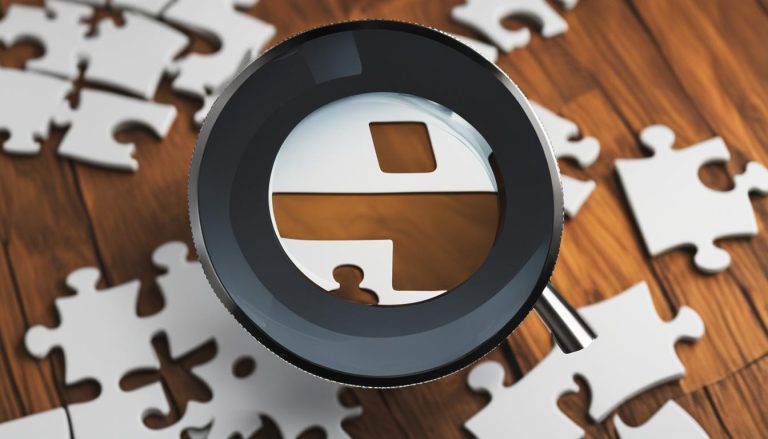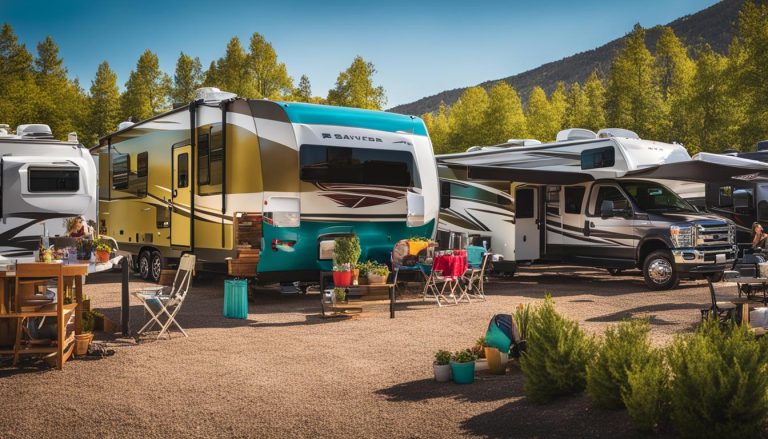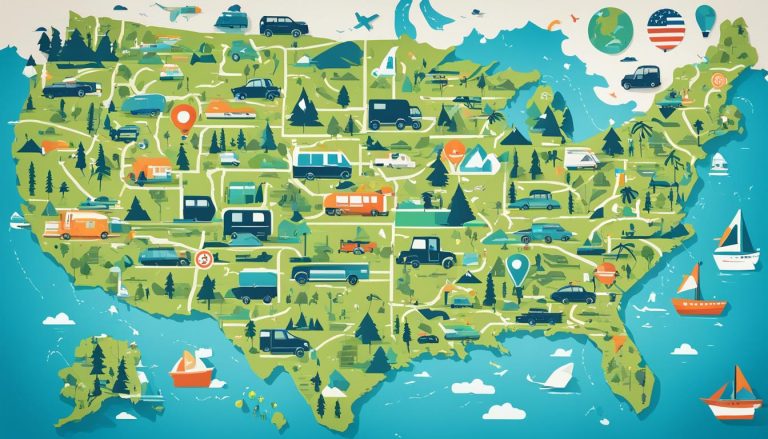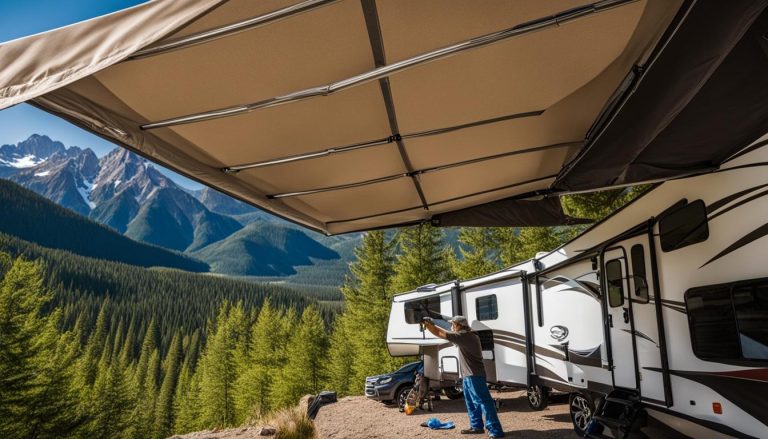RV Tank Cleaning: Deodorize Holding Tanks Effectively
gorvlifestyle.com and its partners may earn a commission if you purchase a product through one of our links
Cleaning and deodorizing your RV holding tanks is crucial for maintaining a fresh and pleasant environment during your travels. Neglecting this important maintenance task can lead to unpleasant odors and potential issues with your tank sensors. Fortunately, there are effective methods and products available to ensure optimal cleanliness and functionality of your RV holding tanks.
When it comes to cleaning and deodorizing your RV holding tanks, finding the most efficient and effortless method is key. In this article, we will explore some tips and techniques that will help you keep your tanks clean and odor-free on your next adventure.
Key Takeaways:
- Regularly cleaning and deodorizing your RV holding tanks is essential for preventing unpleasant odors and maintaining optimal functionality.
- Keep at least 5 gallons of water in your tanks to prevent buildup and drying out, and swish water as you travel to clean the tank’s sides.
- Use enzymatic RV holding tank treatments for effortless and effective cleaning. Products like Super Seal Pirranha, Thetford Tank Blaster, and Walex CMDOBG Commando Black Holding Tank Cleaner can break down waste and buildup overnight.
- Follow the recommended steps for using enzymatic treatments, including filling the tanks before emptying, using warm water, and allowing the treatment to sit overnight for optimal results.
- For deep cleaning, use bacteria-based cleaners like Unique Clean-It for black tanks and grease-eating dish soap like Dawn Ultra for gray tanks. Let the cleaners sit before thoroughly flushing and rinsing the tanks.
Tips to Maintain Clean and Odor-Free RV Holding Tanks
To maintain clean and odor-free RV holding tanks, there are several tips to keep in mind.
1. Keep at least 5 gallons of water in the tanks:
Keeping a minimum of 5 gallons of water in the tanks helps prevent buildup and drying out. This ensures that the tanks remain in good condition and helps reduce unpleasant odors.
2. Swish water as you travel:
While on the road, try to swish water in the tanks by taking sharp turns or using road bumps. This motion helps clean the tank’s sides and prevents waste from sticking to the walls.
3. Keep gate valves closed until tanks are at least half full:
By keeping the gate valves closed until the tanks are at least half full, you prevent the tanks from drying out. This is particularly important during periods of non-use and helps maintain the effectiveness of the tank’s contents.
4. Flush digested materials and RV-safe toilet paper only:
To avoid blockages and maintain efficient tank performance, only flush down the toilet digested materials and RV-safe toilet paper. Other substances can cause clogs and damage to the tanks.
5. Avoid using harsh chemicals or bleach:
When cleaning your RV holding tanks, refrain from using harsh chemicals or bleach. These substances can damage the tanks and seals, compromising their integrity and potentially leading to expensive repairs or replacements. Stick to RV-specific cleaning products to ensure safe and effective cleaning.
By following these tips, you can ensure that your RV holding tanks remain clean, odor-free, and in optimal working condition.
The Power of Enzymatic RV Holding Tank Treatments
When it comes to DIY RV holding tank cleaning, one of the most effective and hassle-free methods is using enzymatic tank treatments. These natural deodorizers for RV holding tanks contain powerful enzymes that break down and liquefy waste and buildup, leaving your tanks clean and odor-free.
Enzymatic products, such as Super Seal Pirranha, Thetford Tank Blaster, and Walex CMDOBG Commando Black Holding Tank Cleaner, are specifically designed for overnight cleaning. By following the manufacturer’s instructions, you can effortlessly clean your RV holding tanks while you sleep, saving you time and effort.
Enzymatic tank treatments work by harnessing the power of enzymes to break down organic matter and eliminate odors. These enzymes penetrate the waste and debris in your tanks, breaking them down into smaller molecules that can be easily flushed out. The result is a thorough cleaning and fresh-smelling RV holding tanks.
Using enzymatic RV holding tank treatments offers several advantages. Firstly, it provides a natural and eco-friendly alternative to harsh chemicals that can harm the environment. Enzymes are biodegradable and safe to use in your RV tanks. Additionally, these treatments are highly effective, even on stubborn waste and buildup, ensuring a thorough cleaning every time.
When using enzymatic tank treatments, it is important to follow the instructions provided by the manufacturer. Each product may have specific guidelines for dosage and application. By following these instructions, you can maximize the effectiveness of the treatment and achieve the best results for your RV holding tanks.
To summarize, enzymatic RV holding tank treatments offer a convenient and efficient way to clean and deodorize your tanks. These natural deodorizers for RV holding tanks break down waste and buildup, leaving your tanks fresh and odor-free. By choosing the right enzymatic tank treatment and following the manufacturer’s instructions, you can easily maintain clean and healthy RV holding tanks.
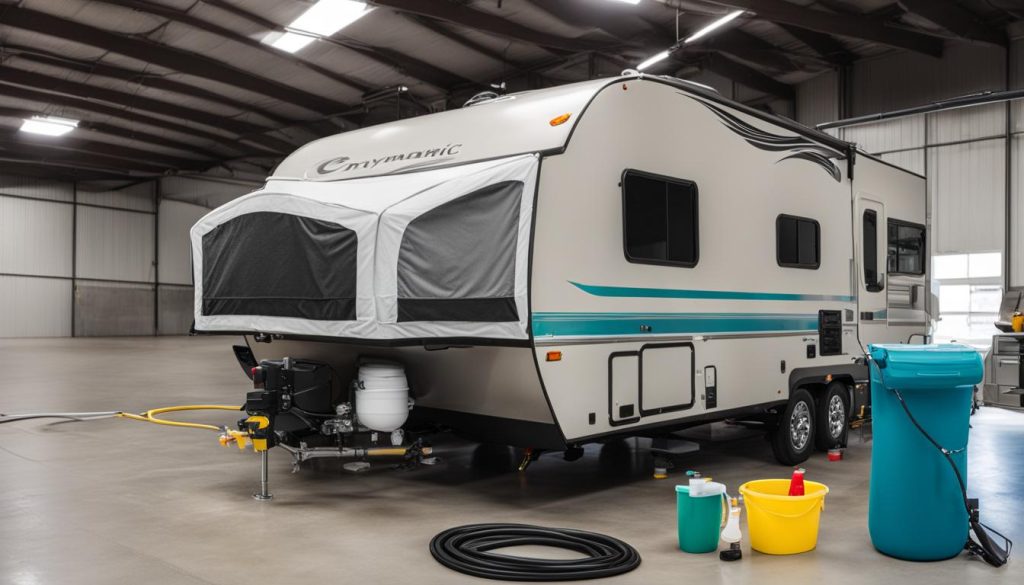
An enzymatic tank treatment can help you effortlessly clean and deodorize your RV holding tanks.
Steps to Use Enzymatic RV Holding Tank Treatments
To get the best results from enzymatic RV holding tank treatments, follow these simple steps:
- Use the treatment while connected to sewer services to allow the tanks to fill up before emptying them.
- Fill each tank to more than 75% of capacity for better cleaning.
- Empty the black tank before the gray tank, as the soapy water from the gray tank can help clean the sewer hose.
- Mix the recommended dose of the tank treatment with warm water and dump it down the toilet before bed.
- Fill the tanks with water in the morning and test the cleanliness by checking for any offensive odors.
Following these steps ensures that the enzymatic treatment is properly distributed throughout the tanks, breaking down waste and eliminating odors effectively.
The Power of Enzymatic RV Holding Tank Treatments
“Enzymatic products, such as Super Seal Pirranha, Thetford Tank Blaster, and Walex CMDOBG Commando Black Holding Tank Cleaner, contain enzymes that break down and liquefy waste and buildup in the tanks.”
Enzymatic RV holding tank treatments are highly efficient in eliminating waste and buildup. By using enzymes to break down and liquefy waste, these products offer an effortless and hassle-free cleaning experience. They are specifically designed for overnight cleaning, allowing you to wake up to fresh and odor-free RV holding tanks.
It is crucial to carefully follow the manufacturer’s instructions when using enzymatic RV holding tank treatments for optimal results. With proper usage, these treatments provide a powerful and reliable method to clean and deodorize your RV holding tanks.
Now that you know the best method to clean RV holding tanks using enzymatic treatments, let’s explore further deep cleaning techniques for both black and gray tanks.
Deep Cleaning RV Holding Tanks: Black and Gray
Deep cleaning RV holding tanks is essential to remove stubborn buildup and ensure thorough cleaning. Neglecting proper cleaning can lead to foul odors and compromised functionality. To deep clean your black tank, follow these steps:
- Fill the black tank with water until it reaches at least 3/4 full.
- Add a bacteria-based cleaner, such as Unique Clean-It, following the manufacturer’s instructions.
- Let the cleaner sit in the tank for 12-72 hours to break down waste and buildup.
- After the recommended time, flush and rinse the tank thoroughly.
To deep clean your gray tank, the process is slightly different:
- Fill the gray tank with water until it is almost full.
- Add grease-eating dish soap, like Dawn Ultra, to the tank.
- Let the soap sit in the tank overnight.
- Rinse the tank thoroughly to remove any residue.
Remember to always follow the manufacturer’s instructions for any cleaning products you use. Proper deep cleaning of both the black and gray tanks will help maintain a clean and odor-free RV.
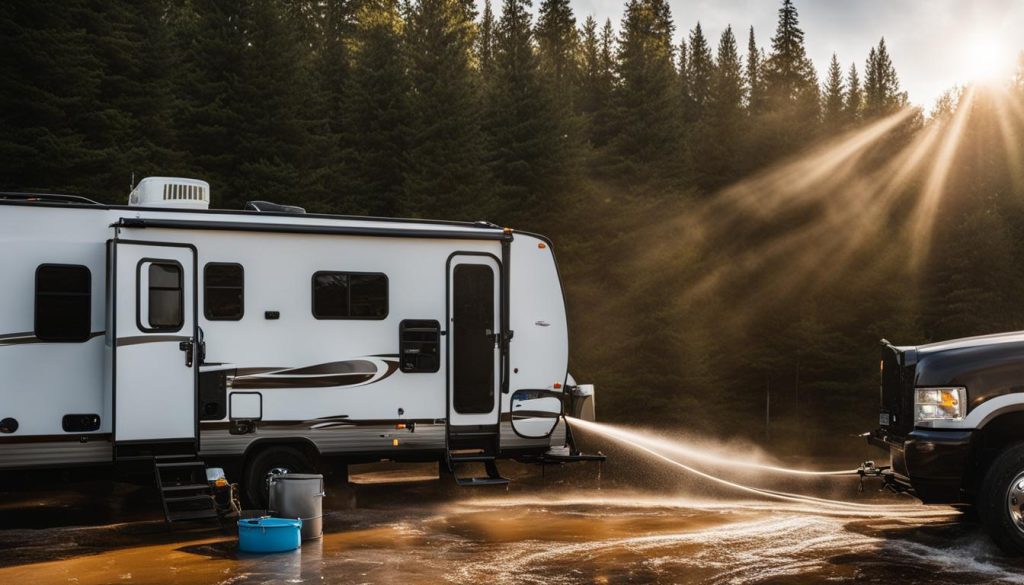
Additional Tips for Effective Cleaning and Deodorizing
In addition to deep cleaning, there are some other tips and tricks to keep your RV holding tanks clean and odor-free:
- Use hot water for rinsing the tanks, as hot water can help dissolve waste and flush it out more effectively.
- Use a sink strainer to prevent food particles and debris from entering the gray tank, reducing the risk of clogs and odors.
- Before washing dishes, wipe off excess grease and debris to minimize buildup in the gray tank.
By following these tips and regularly deep cleaning your RV holding tanks, you can ensure a pleasant and hassle-free camping experience.
Modified Deep Cleaning for Full-Time RVers
As a full-time RVer, maintaining clean and odor-free holding tanks is an ongoing task. Regular use of these tanks requires a modified deep cleaning process to prevent buildup and ensure optimal functionality. Here are some effective techniques for cleaning your RV holding tanks and natural deodorizers to keep them fresh:
Cleaning Black Tanks
To clean black tanks regularly, we recommend using Unique Clean-It. This bacteria-based cleaner is specially designed to break down waste and eliminate odors. Follow the instructions on the product label for the appropriate dosage and usage.
Cleaning Gray Tanks
For weekly cleaning of gray tanks, Dawn Ultra dish soap works wonders. Its grease-eating properties help remove residue and keep your tank smelling fresh. Simply add a small amount of Dawn Ultra to warm water and let it sit in the tank overnight before rinsing thoroughly.
By following these modified cleaning techniques for black and gray tanks, you can ensure continuous maintenance and prevent the buildup of waste and odors in your RV holding tanks. Remember to always use RV-safe cleaning products and follow the manufacturer’s instructions for optimal results.
For additional tips on effective cleaning techniques and natural deodorizers for RV holding tanks, continue reading our article.
Combo Tanks and Additional Tips
Combo tanks serve as both black and gray water tanks in your RV, and they require special attention when it comes to cleaning. Depending on whether you predominantly use the tank for black water or gray water, you should follow the appropriate steps for deep cleaning.
If your combo tank is used mostly for black water, you can use the same method as deep cleaning a regular black tank. On the other hand, if it is primarily used for gray water, follow the steps for deep cleaning a gray tank. Regular maintenance of combo tanks is crucial to prevent unpleasant odors and ensure optimal functionality.
In addition to cleaning, here are some additional tips to effectively clean and deodorize your RV holding tanks. When rinsing your tanks, try using hot water as it helps to break down waste and residue. Using a sink strainer can prevent debris from entering the tanks, minimizing the risk of clogs. Before washing dishes, it is a good practice to wipe off any grease and debris, reducing the amount of waste that enters the tanks and potentially causing odors.
By following these tips and properly maintaining your combo tanks, you can enjoy a fresh and odor-free RV experience while on the road.
FAQ
How often should I clean and deodorize my RV holding tanks?
It is recommended to clean and deodorize your RV holding tanks regularly, at least once every few months or as needed, to prevent unpleasant odors and maintain optimal functionality.
Can I use regular household cleaning products to clean my RV holding tanks?
No, it is not recommended to use regular household cleaning products, such as bleach or harsh chemicals, to clean your RV holding tanks as they can damage the tanks and seals. Instead, use specialized RV tank cleaners and deodorizers.
How much water should I keep in my RV holding tanks?
It is important to keep at least 5 gallons of water in your RV holding tanks to prevent buildup and drying out. Swishing water as you travel can also help clean the tank’s sides.
What is an enzymatic RV holding tank treatment?
An enzymatic RV holding tank treatment is a product that uses enzymes to break down and liquefy waste and buildup in the tanks. These treatments are designed for overnight cleaning and offer effortless cleaning.
What is the best method to clean RV holding tanks?
One of the most effective methods to clean RV holding tanks is to use an enzymatic RV holding tank treatment. These treatments break down waste and buildup overnight, making the cleaning process simple and efficient.
How do I deep clean my RV black tank?
To deep clean your RV black tank, fill the tank with water and add a bacteria-based cleaner. Let the cleaner sit in the tank for 12-72 hours before flushing and rinsing the tank.
How do I deep clean my RV gray tank?
To deep clean your RV gray tank, fill the tank with water and add grease-eating dish soap. Let it sit overnight and thoroughly rinse the tank afterwards to remove any residue.
How should I clean and maintain my combo tanks?
If your combo tank is predominantly used for black water, follow the steps for deep cleaning a black tank. If it is used for gray water, follow the steps for deep cleaning a gray tank. Regular maintenance is essential to prevent odors and ensure optimal functionality.
Are there any additional tips for cleaning and deodorizing RV holding tanks?
Yes, some additional tips include using hot water for rinsing, using a sink strainer to catch debris, and wiping grease and debris off dishes before washing to prevent clogs in the tanks.

